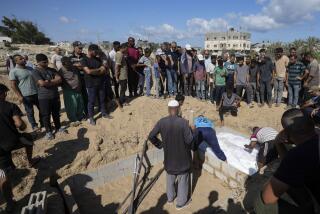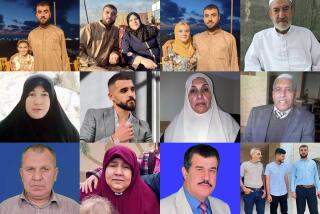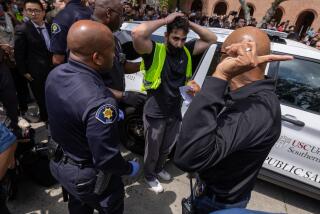Bone by bone, Iraqis unearth a mass grave: ‘We will be out there digging until no one is left’

WARNING: This video contains graphic content. As the Iraqi-led coalition advances into Mosul, residents returning to surrounding villages have discovered several mass graves. (Video by Molly Hennessy-Fiske / Los Angeles Times)
Reporting from AL HOUD, Iraq — The skull still had a thatch of brown hair attached. The lower jaw was missing, and the forehead had a hole in it.
“Many of the bodies, the hands were tied. They were blindfolded and shot in the forehead,” said Omar Hasan as he surveyed remains scattered beside a sinkhole Islamic State had turned into a mass grave.
A captain in a local Sunni tribal militia that polices the area around the village of Al Houd since it was freed in November, Hasan helped excavate the mass grave, where locals found 25 remains. But land mines planted by Islamic State have already killed some volunteers.
Hasan suspects the sinkhole was used to dump victims from Al Houd until last year. Excavators have found women’s veils, children’s clothes and severed heads. So far, none of the remains have been identified.
Hasan, 30, pointed to a long bone affixed with a metal plate. It brought to mind a police officer he knew, who was wounded in the leg by a roadside bomb and then went missing after Islamic State seized the town in 2014.
“That’s him. I’m sure,” Hasan said.
Mass graves are all too familiar in Iraq. Even before the rise of Islamic State, Iraqi authorities struggled to cope with the task of excavating mass burials from the reign of Saddam Hussein, when up to a million Iraqis disappeared.
But recent discoveries underscore the savagery of Islamic State. In Al Houd 118 people went missing under two years of the jihadists’ rule. Two of them were Hasan’s relatives.
As the Iraqi-led coalition advances into Mosul, residents returning home have grown impatient with government officials responsible for investigating mass graves and are starting themselves, sometimes with deadly results.
Ten days ago, a mine exploded at Al Houd, killing four Sunni militia members who had been digging and trying to defuse a second mine planted nearby, Hasan said.
Late last month, a booby trap at another massive desert grave farther south of here killed half a dozen visitors including a Shiite militia commander and Shifa Gardi, 30, a Kurdish television reporter. The grave, also in a sinkhole, is known as the khasfa, and located in an area called the Valley of Death.
The United Nations and other international groups have suggested some of the mass graves may indicate genocide or war crimes, and Human Rights Watch has called on the Iraqi government to preserve the sites.
Fawaz Abdulabbas, deputy head of the Iraq program for the International Commission on Missing Persons, which assists Iraqi government officials with excavating mass graves, said no current total exists of mass graves in Iraq.
“No one can say that — we are finding new ones every day,” he said.
The Associated Press documented at least 72 mass graves from Islamic State in Iraq and Syria, containing as many as 15,000 bodies, as of last summer. More graves have been found since.
Dozens of mass graves around the northern town of Sinjar likely contain the remains of hundreds of Yazidi religious minorities executed by Islamic State (those digging at Al Houd claim Yazidi women were killed there, too). Farther south, mass graves around the city of Tikrit contain the remains of an estimated 1,700 soldiers from Camp Speicher massacred by the militants three years ago.
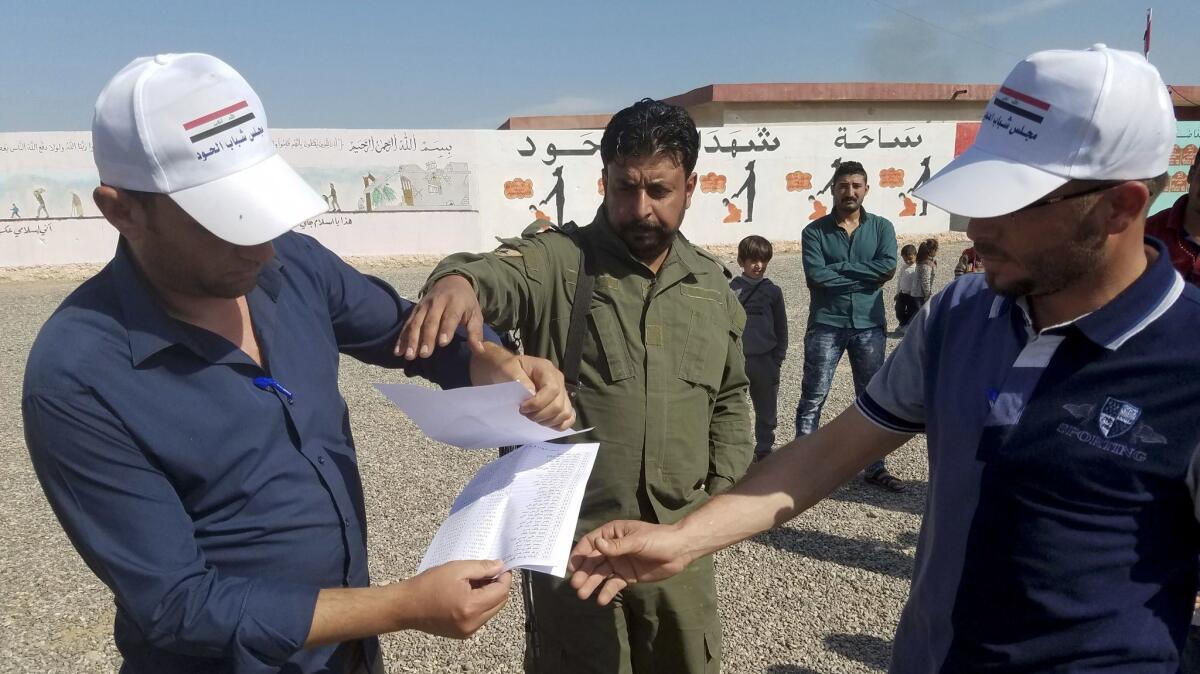
Abdulabbas’ group and Iraq’s forensic team were excavating at the Camp Speicher site this week. He said they have identified scores of mass graves in Sinjar, but that they “are full of booby traps” and have been fenced off until they can be cleared.
In addition to risking their lives, untrained volunteers excavating mass graves risk contaminating them, Abdulabbas said. That’s what happened in 2003, he said, when families dug at mass graves south of Baghdad from a 1991 Shiite uprising, disrupting the site.
“They destroyed evidence, even the remains, because they are not experts,” Abdulabbas said. “What we are trying to do is collect information from the families and try to help with the exhumation.”
Belkis Wille, senior Iraq researcher at Human Rights Watch, said she knows of at least a dozen mass graves in northern Iraq alone, one of which — the massive grave known as khafsa, which she visited recently — may contain thousands of bodies.
She said it would take months to remove land mines “and the de-mining organizations are overloaded trying to decontaminate areas for returns, so this is just not going to be the priority.”
Portions of some mass graves, such as one north of Al Houd in Hamam Alil that Wille estimates could contain 300 bodies, are fenced off with warning signs posted by Abdulabbas’ group.
But even the Hamam Alil site wasn’t marked with land mine warnings or guarded this week, when locals could be seen walking across it.
“Don’t walk there — it’s not clear yet!” cautioned Mohammed Yaseen, a Sunni militia member whose three cousins, former policemen executed by Islamic State when they tried to flee last October, were found buried at the site with their identifications.
Yaseen, 21, said Iraqi forces are still busy removing mines from more populated, heavily-trafficked parts of town. But he understands why families come to search for their dead, despite the risks. They found the remains of women and children, including a newborn. Some of the bodies had been beheaded.
Yaseen pointed to the spot where his cousins were found.
“The bodies were left on the ground like trash,” he said, repeating an Arabic proverb: “To honor the dead is to bury them.”
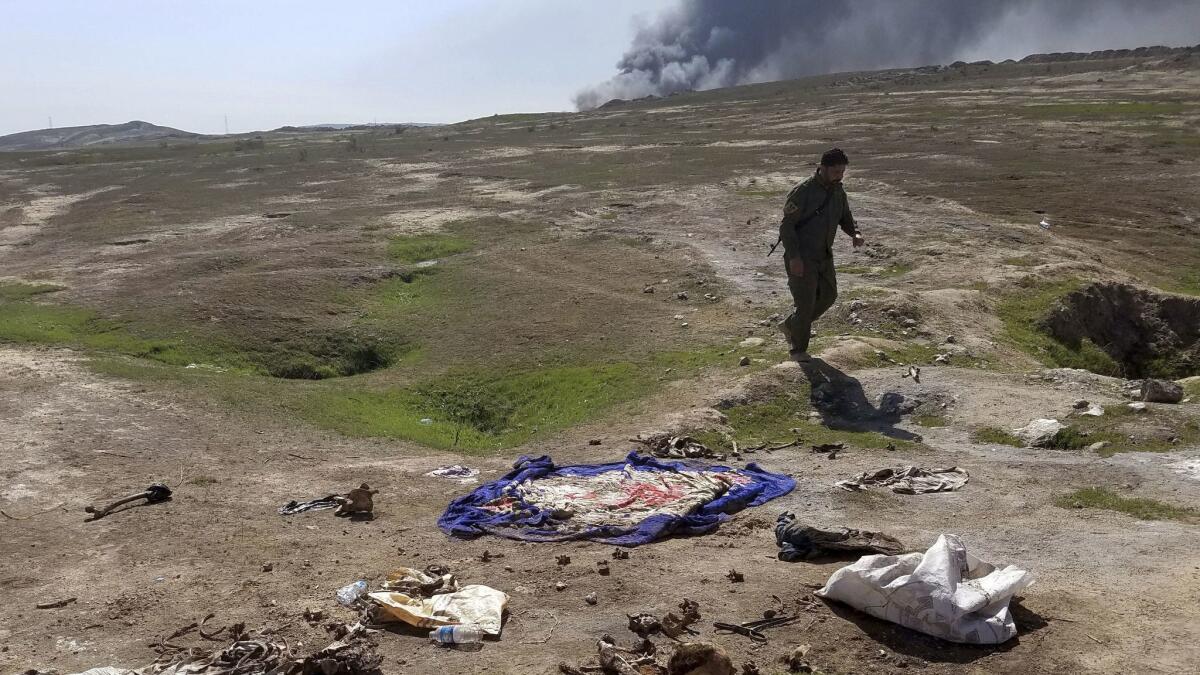
There are also practical reasons relatives dig: it can be difficult to claim government pensions and other benefits without a death certificate. At Al Houd, volunteers were taking remains to a nearby hospital for DNA tests. The excavation was halted after the explosion on Feb. 28.
Local volunteers claim to have located or defused about 200 land mines, marking them with gray stones that blend into the landscape. They plan to return soon, once local experts deem the site safe.
Until then, remains they had intended to deliver to the hospital sit exposed to the elements and mixed with clothing and debris at the remote site about five miles from the main road through town. When the wind shifts, the stench rises.
Flies circled a second skull, a torso and two desiccated hands that sat next to a brown sandal and a flowered blanket. Beside them, inside an open white grain sack, a partial skeleton was jumbled together. In a field several yards away, a foot protruded from a pair of blue drawstring pants.
“Animals dragged it,” said fellow Sunni militia member Sgt. Major Yasser Ahmed, 37, who has also been digging at the site.
Ahmed frowned, shaking his head. Sunni dissatisfaction with the Shiite-dominated central government initially helped fuel support for Islamic State in the Mosul area. Many residents now credit Iraqi forces with freeing villages like Al Houd, but the longer mass graves sit unattended, the more unrest builds.
“As Sunnis, no one is helping us with this issue,” Ahmed said. “They don’t know how to handle our problems. We are not happy with what the government is doing.”
Another fellow militia member, Salam Khalaf, 31, lost 28 members of his family under Islamic State, including a brother. He refuses to dig at the site until professionals arrive to excavate properly. But he is the exception.
“It’s a disaster what’s happening to the bodies there. It’s hard for us to identify them. We need the government, some NGOs or international institutions to come and check,” said Saad Hussein Ali, 43, who runs a shawarma stand in town and knows 34 of those still missing.
Even the father of a 21-year-old killed defusing the land mine at the mass grave said he understands why people dig at the site and would not try to dissuade them.
“We tried the local authorities, the federal government, even asked for help from the [U.S.-led] coalition. But we don’t think it will happen soon. So we will get the bodies,” said Hussein Hassan, 30, a Sunni lawyer who had been digging in search of 26 dead or missing relatives the day the land mine exploded.
As he reviewed a list of the missing in a local square dedicated to children executed there by Islamic State, Hassan said he plans to return to dig at the mass grave again soon.
“We will not leave anyone behind,” he said. “We will be out there digging until no one is left.”
molly.hennessy-fiske@latimes.com
ALSO
Iraqis relieved to be left off Trump’s new travel ban
In Mosul, desperate families dodge bullets to reach safety: ‘There’s a sniper here’
The teachers are unpaid and danger is ever present, but Mosul’s schools are reopening
More to Read
Sign up for Essential California
The most important California stories and recommendations in your inbox every morning.
You may occasionally receive promotional content from the Los Angeles Times.

